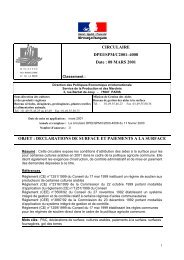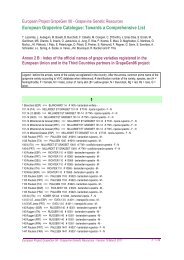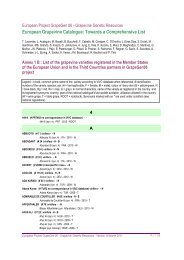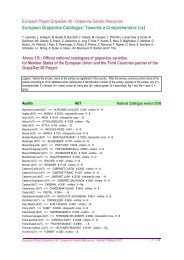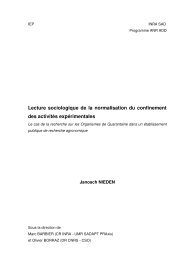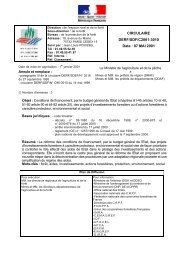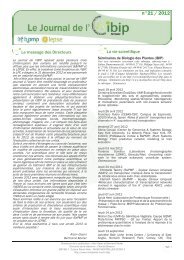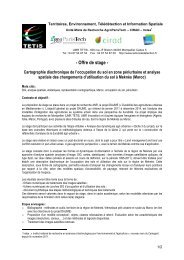C-Viro - INRA Montpellier
C-Viro - INRA Montpellier
C-Viro - INRA Montpellier
You also want an ePaper? Increase the reach of your titles
YUMPU automatically turns print PDFs into web optimized ePapers that Google loves.
épidémiologie du TYLCV<br />
Centre de Biologie et de Gestion des Populations (CBGP)<br />
& <strong>INRA</strong> d'Alénya<br />
Participants :<br />
* O. BONATO - IRD<br />
* C. CLOUET - <strong>INRA</strong><br />
* N. GAUTHIER - IRD<br />
* F. PELLEGRIN - IRD<br />
* G. RIDRAY - <strong>INRA</strong>. Alénya<br />
* B. SERRATE - <strong>INRA</strong><br />
* J.M. THUILLIER - <strong>INRA</strong><br />
* H. VERMEIL de CONCHARD - <strong>INRA</strong>
Etat des lieux
Répartition des sites de prélèvements<br />
Zone non<br />
prospectée<br />
Zone non<br />
prospectée
Synthèse des investigations<br />
Enquêtes épidémiologiques<br />
Développement d’outils moléculaires de<br />
diagnostics précoces.<br />
Mise en évidence de la présence du TYLCV<br />
(Catalogne, Roussillon, Midi-Pyrénées, Tunisie)<br />
TYLCV signalé<br />
TYLCV avéré (datura & tomate 2003)<br />
TYLCV avéré (datura & tomate 2004)<br />
Sites de suivis épidémiologiques<br />
TYLCV signalé (tomate 2003)<br />
TYLCV avéré (datura & tomate 2006-2008)<br />
Stations d’épidémio-surveillance dans les<br />
bassins de référence en Catalogne et Roussillon<br />
(piégeages).<br />
Mise en évidence de contaminations par le<br />
TYLCV sur plantes spontanées. Franchissement de<br />
la barrière hivernale.<br />
Caractérisation du développement de foyers<br />
primaires dans les serres.<br />
Plantes hôtes du TYLCV (annuelles ou pérennes)
Les outils de diagnostics
Efficacité comparée des techniques pour le<br />
diagnostic du TYLCV<br />
Elisa = nombre important de faux-négatifs (sensibilité médiocre)<br />
PCR multiplex avec amorces spécifiques des TYLCV-Is et TYLCV-Sar<br />
(M. Peterschmitt & A. Tahiri)<br />
Extractions d'ADN<br />
Q = kit Qiagen<br />
K = kit Q-Biogen<br />
Q => nb d'éch. NON dilués positifs = 44/47 93,60%<br />
Q => nb d'éch. DILUES positifs = 14/34 41,20%<br />
K => nb d'éch. NON dilués positifs = 4/47 8,50%<br />
K => nb d'éch. DILUES positifs = 18/46 39,10%
Epidémio-surveillance
Piégeages<br />
• Mise en évidence de la présence du<br />
TYLCV à l’aide de plantes témoins<br />
(Tomate, Morelle, Datura, Lysianthus,<br />
…) entourées de plantes attractives<br />
pour Bemisia (Lantana, Gerbera,<br />
Aubergine, Althea, …)<br />
• Prélèvements réguliers (toutes les<br />
3 semaines) de mai à novembre,<br />
remplacement des plants infectés.
Résultats<br />
Piégeages : premiers<br />
pièges positifs (Tomate<br />
& Datura) mi-juin en<br />
Roussillon.<br />
Début août (Datura,<br />
Lysianthus & Morelle)<br />
en Catalogne
Plantes refuge-réservoir<br />
Barrière hivernale
Recherche de plantes refugesréservoirs<br />
Une large gamme de plantes, adventices ou<br />
cultivées, en adéquation avec la bibliographie<br />
Fichiers : www1.montpellier.inra.fr/CBGP/<br />
Site : BemisiaRisk<br />
• Plantes annuelles « strictes » (estivales)<br />
• Plantes à chevauchement de cycles<br />
• Plantes vivaces
Recherche du TYLCV en Catalogne et Roussillon<br />
Végétaux éch. Analysés éch. Positifs<br />
Adventices spontanées 1130 390<br />
Florales ou Horticoles 414 133<br />
Maraîchères 742 308 (1 TYLCV-Sar)<br />
Recherche du TYLCV en Tunisie & Maroc<br />
éch. Analysés<br />
éch. Positifs<br />
Tunisie 105 12 TYLCV-Is<br />
16 TYLCV-Sar<br />
15 TYLCV-Is & Sar<br />
Maroc => situation comparable : forts risques d'une évolution<br />
dangereuse du TYLCV par recombinaison.<br />
(cf. la présentation de C. URBINO du BGPI)
Diversité des TYLCV<br />
Série 1<br />
dominante Roussillon<br />
(7 haplotypes/13)<br />
Série 2<br />
dominante Espagne<br />
(4 haplotypes/13)<br />
Série 3<br />
Tunisie<br />
(2 haplotypes/13)
Echantillonnages printemps 2009 sur repousses de plantes<br />
refuges-réservoirs trouvées infectées en automne 2008<br />
Automne Printemps<br />
éch. Totaux TYLCV éch. Totaux TYLCV<br />
ROUSSILLON 108 63 16 12<br />
CATALOGNE 95 60 11 9
Evolution des foyers de TYLCV<br />
sous serre
Campagne 2006-2007 (début infection = sept-oct )<br />
Total plants = 9800 variété Cheer, plantation août 2006<br />
Plants coupés début décembre 2006 (symptômes TYLCV) = 319<br />
Relevés de début décembre 2006 (diagnostics visuels) = 512<br />
Diagnostics Elisa (SEDIAG & ADGEN) => 20 éch. négatifs<br />
Diagnostics PCR multiplexe => 67 éch. (2 foyers + 3 transects) = 44 positifs
Culture de tomate (var. Climberley) sous serre chauffée, distribution<br />
réelle de plants TYLCés autour d'un foyer primaire 2009-2010<br />
ABSENCE apparente de Bémisia<br />
Prélèvements du 04/11/09 (Foyer initial) 26 éch. = 26 TYLCV<br />
Prélèvements du 18/11/09<br />
12 éch. = 9 TYLCV<br />
Prélèvements du 09/12/09<br />
20 éch. = 7 TYLCV<br />
79 échantillons (04 & 18-11 + 09-12-2009) = 55 positifs TYLCV par PCR = 70%.<br />
Avec symptômes le 11-02-2010 = 16 soit 30% (mais 0 positifs au TYLCV par PCR sur<br />
prélèvements tiges complémentaires)<br />
Avec symptômes le 02-04 = 32 soit 58% (TYLCV seul ou TYLCV + Botrytis )<br />
x 57 x x 1 tige coupée<br />
x 53 x x x 54 x x RAS x 55 x x 1 tige coupée x 56 x x 1 tige coupée<br />
x 52 x x RAS<br />
x x x 37<br />
x 51 x x tout coupé<br />
x x x 36<br />
x x 35 x 1 tige coupée<br />
x 17 x x RAS<br />
x x16 15 12 x x x<br />
x 14x13 10 11 x x 8,10,12 = RAS tout coupé RAS 1 tige coupée<br />
1 tige coupée 1,3,4 = RAS 9 8 7 A 1 2 3 x x x 26 x x x 27 x x x 28 x x 38 x x x 39 x x x 40 x x x 41 x x x 42 x x x 43 x x<br />
x 31 x x x 30 x x x 29 x x 6 5 4 20 19 18xx A = tout coupé<br />
1 tige coupée 1 tige coupée x 22 21 24 x 25 x x 18,20,21 = RAS<br />
x 23 x x RAS<br />
x x x 32 RAS<br />
x x x 33 RAS<br />
x x x 34 RAS<br />
x 44 x x<br />
x 45 x x<br />
RAS<br />
x 46 x x x 47 x x x 48 x x x 49 x x<br />
x 50 x x
Culture de tomate (var. Climberley) sous serre chauffée, distribution<br />
réelle de plants TYLCés autour d'un foyer primaire 2009-2010<br />
PRESENCE initiale de Bémisia forte<br />
Prélèvements du 04-11-2009 => 21 éch. = 20 TYLCV (PCR)<br />
Relevé du 02-04-2010 =><br />
* 240 plants dont 88 coupés car symptômes de TYLCV<br />
* sur les 20 positifs du 04-11 => 13 avec symptômes (65 %)<br />
Pain 15 26<br />
Allées<br />
x x x x x x x x x x x x x 21 x x x x x 20 x x x 19 x 18 x 17 x 16<br />
64<br />
x x x x x x x x 9 x x x 8 x x x 7 x x 6 x x x x 5 4 3 2 1 B<br />
63 62<br />
x x x x x x x x x x x x x 15 x x x x x 14 x x x 13 x 12 x 11 x 10<br />
61 60<br />
x x x x x x x x x x x x x x x x x x x x x x x x x x x x x x<br />
59 58<br />
x x x x x x x x x x x x x x x x x x x x x x x x x x x x x x<br />
57 56<br />
x x x x x x x x x x x x x x x x x x x x x x x x x x x x x x<br />
55 54<br />
x x x x x x x x x x x x x x x x x x x x x x x x x x x x x x<br />
53 52<br />
x x x x x x x x x x x x x x x x x x x x x x x x x x x x x x
Gestion d'un foyer débutant<br />
* Eradiquer dans et autour des serres les plantes<br />
susceptibles d'héberger le TYLCV<br />
* Contrôler avec rigueur la prolifération des vecteurs<br />
* Eliminer progressivement les plants infectés (suivi<br />
des symptômes)
FIN épidémiologie TYLCV<br />
Présentation de C. URBINO<br />
(BGPI)
Les sites de prélèvements en Roussillon<br />
MIN Saint Charles<br />
Pézilla de la Rivière<br />
Exploitation maraîchère<br />
POMES<br />
Toulouges<br />
Le Tech<br />
Jardin FIGUERES<br />
Palau del Vidre<br />
Horticulture LANOY<br />
La Têt<br />
Saint Nazaire<br />
Saleilles<br />
Le Réart<br />
Maraîchage de plein champ<br />
DARDENE<br />
Alénya<br />
Cartographie IGN Bd ortho 2004 et GAIA Mapping 2005
Les sites de prélèvements en Catalogne espagnole<br />
Cabrils<br />
Calella<br />
Santa<br />
suzanna<br />
SELMAR<br />
Maresme nord<br />
I.R.T.A<br />
Maresme sud<br />
Cabrera de mar<br />
Viladecans<br />
J MARTINEZ<br />
J PUIG VENTOS<br />
F SAMPERA<br />
Baix llobregat<br />
Cartes Google Earth
ADVENTICES<br />
Caractéristiques<br />
Total TYLCV Total échantillons<br />
Nom commun<br />
SPONTANEES<br />
biologiques<br />
(E = Espagne) (E = Espagne)<br />
Agastache sp. - vivace 0 1<br />
Amaranthus viridis Amaranthe annuelle 0 5<br />
Araujia sericifera vivace 0 1<br />
Chenopodium album Chenopode blanc annuelle 4 (1 E) 10 (1 E)<br />
Cleome viscosa - annuelle 0 1<br />
Convolvulus arvensis Liseron des champs vivace 1 3<br />
Datura stramonium Stramoine annuelle 144 (12 E) 299 (80 E)<br />
Ecballium elaterium Cornichon d'âne vivace 0 2<br />
Lactuca serriola - annuelle 0 4<br />
Lavatera arborea - vivace 6 (3 E) 21 (6 E)<br />
Macroptilium sp. - annuelle 0 2<br />
Malva parviflora Mauve à petites fleurs annuelle ou bisannuelle 32 (4 E) 110 (25 E)<br />
Mercurialis ambigua Ambiguë annuelle 22 (4 E) 47 (9 E)<br />
Osteospermum sp. - vivace 0 7<br />
Parietaria judaica Pariétaire de Judée vivace 1 3<br />
Picris echioides Picris fausse vipérine annuelle ou bisannuelle 0 2<br />
Salvia pratensis Sauge bisannuelle 0 4<br />
Solanum luteum Morelle jaune annuelle ou bisannuelle 7 (4 E) 24 (15 E)<br />
Solanum nigrum Morelle noire annuelle ou bisannuelle 72 (9 E) 340 (85 E)<br />
Sonchus asper Laiteron rude annuelle 2 40<br />
Sonchus oleraceus Laiteron maraîcher annuelle 99 (38 E) 163 (75 E)<br />
Verbascum thapsus Bouillon blanc bisannuelle 0 1<br />
FLORALES OU<br />
Caractéristiques<br />
Total TYLCV Total échantillons<br />
Nom commun<br />
HORTICOLES<br />
biologiques<br />
(E = Espagne) (E = Espagne)<br />
Abutilon sp. Abutilon vivace 4 18<br />
Alcea rosea Rose trémière vivace 4 16<br />
Bacopa campanulata - vivace 1 6<br />
Brugmancia suavolens Datura décoratif vivace 1 9<br />
Cuphea llavea Face de chauve souris vivace 1 3<br />
Eryops chrysanthemoïdes Marguerite jaune vivace 0 1<br />
Fuschia hybride - vivace 2 21<br />
Gerbera hybride - annuel 2 7<br />
Hibiscus rosa sinensis Rose de chine vivace 5 (2 E) 28 (8 E)<br />
Ipomea sp. Ipomée annuelle 1 9<br />
Lantana camara Lantanier vivace 50 (1 E) 143 (11 E)<br />
Eustoma grandiflora Lysianthus annuelle 60 (27 E) 140 (58 E)<br />
Physialis peruviana Coqueret du Pérou annuelle 0 4<br />
Solanum bonariense Morelle de Buenos Aires vivace 0 6<br />
Tagetes erecta Rose d'inde annuelle 2 3<br />
MARAICHERES<br />
CULTIVEES<br />
Bilan des végétaux analysés ( Catalogne espagnole et France )<br />
Nom commun<br />
Caractéristiques<br />
biologiques<br />
Total TYLCV<br />
(E = Espagne)<br />
Total échantillons<br />
(E = Espagne)<br />
Capsicum chinense Poivron annuelle 7 (1 E) 25 (4 E)<br />
Capsicum annuum Piment annuelle 2 4<br />
Cucumis sativus Concombre annuelle 4 (3 E) 50 (17 E)<br />
Lycopersicum esculentum Tomate annuelle 286 (28 E) 640 (141 E)<br />
Nicotiana tabacum Tabac annuelle 3 6<br />
Phaseolus vulgaris Haricot annuelle 2 3<br />
Soja annuelle 2 5<br />
Solanum melongena Aubergine annuelle 0 2<br />
Solanum tuberosum Pomme de terre vivace 2 (1 E) 6 (4 E)<br />
Vitis vinifera Vigne vivace 0 1<br />
Totaux 831(138 E) 2246 (539 E)
Plantes réservoirs du TYLCV en Tunisie<br />
Aubergine Tozeur TYLCV-Is<br />
Courgette Sahel TYLCV-Is<br />
Gerbera Chott Mariem TYLCV-Is<br />
Lantana Chott Mariem TYLCV-Is<br />
Lantana autoroute Hammamet (cap Bon) TYLCV-Is<br />
Lantana Korba (Cap Bon) TYLCV-Is<br />
Lantana Grombalia (Cap Bon) TYLCV-Is<br />
Mauve Sahel (50 kms Sousse) TYLCV-Is<br />
Symbrium irio Sahel TYLCV-Is<br />
Tomate Fatnassa (Kébili) TYLCV-Is<br />
Tomate (var. Amel) Enfidha (Sahel, 50 kms Sousse) TYLCV-Is<br />
Tomate sauvage Tunisie (Amri) TYLCV-Is<br />
Chenopodium muralis Tunisie (vérif) TYLCV-Is + Sar<br />
Courge "Sud" TYLCV-Is + Sar<br />
Conyza bonariensis "Sud" TYLCV-Is + Sar<br />
Fève Tunisie TYLCV-Is + Sar<br />
Lantana Tunisie (Douz, Hôtel Touareg) TYLCV-Is + Sar<br />
Lantana Tunisie (CRRHA) TYLCV-Is + Sar<br />
Malva parviflora Sahel TYLCV-Is + Sar<br />
Malva parviflora "Sud" TYLCV-Is + Sar<br />
Morelle Tunisie (Téboulba) TYLCV-Is + Sar<br />
Morelle Tunisie (Téboulba) TYLCV-Is + Sar<br />
Raphanus raphanistrum "Sud" TYLCV-Is + Sar<br />
tomate Sahel TYLCV-Is + Sar<br />
tomate "Sud" TYLCV-Is + Sar<br />
Tomate Tunisie (Debebcha) TYLCV-Is + Sar<br />
Tomate (déformée) Tunisie (Bazma) TYLCV-Is + Sar<br />
Centaurea Tunisie TYLCV-Sar<br />
Chenopodium muralis Sahel TYLCV-Sar<br />
Convolvulus arventis "Sud" TYLCV-Sar<br />
Fève Tunisie TYLCV-Sar<br />
Figuier Tunisie (Limagnes) TYLCV-Sar<br />
Lantana Tunisie (CRRHA) TYLCV-Sar<br />
Malva parviflora "Sud" TYLCV-Sar<br />
Malva parviflora "Sud" TYLCV-Sar<br />
Malva parviflora "Sud" TYLCV-Sar<br />
Morelle Tunisie (Limagnes) TYLCV-Sar<br />
Morelle Tunisie (Limagnes) TYLCV-Sar<br />
Morelle Tunisie (Jemma) TYLCV-Sar<br />
Morelle Tunisie (Amri) TYLCV-Sar<br />
Raphanus raphanistrum "Sud" TYLCV-Sar<br />
Sonchus oleraceus Sahel TYLCV-Sar<br />
tomate "Sud" TYLCV-Sar
Séquençages<br />
TYLCV-Is<br />
Végétaux<br />
Echantillons Végétal site de prélèvement<br />
Extra<br />
ction<br />
TYLCV GenBank Access° Nber /<br />
% Ident. Nucléot. / Origine TYLCV-Is Végétaux<br />
C'(témoin)<br />
Tomate<br />
Perpignan AJ519441.1 Espagne AJ519441.1<br />
K<br />
3G21<br />
(Pomès) 99 % Spain,,Almeria, Netherlande, RE4 Concombre de serre<br />
K<br />
(Sud Barcelone) 99 % Spain,,Almeria, Netherlande, RE4<br />
2B26<br />
Sonchus oleraceus<br />
Perpignan<br />
K<br />
AJ519441.1<br />
3G2<br />
Tomate de serre<br />
Espagne<br />
K<br />
AJ519441.1<br />
(Pomès) 99 % Spain,,Almeria, Netherlande, RE4 (Sud Barcelone) 99 % Spain,,Maroc,Almeria, Netherlande, RE4<br />
2B18<br />
2A6<br />
2A30<br />
2F1<br />
2F31<br />
T6-Ly2<br />
T6-Ly8<br />
A<br />
A2-D<br />
A48<br />
A55<br />
A74<br />
A82<br />
Hib7<br />
Alcea rosea<br />
Poivron<br />
Lantana<br />
Solanum luteum<br />
Mercurialis ambigua<br />
Lysianthus<br />
Lysianthus<br />
Tomate<br />
Tomate<br />
Tomate<br />
Tomate<br />
Tomate<br />
Tomate<br />
Hibiscus (Pomès)<br />
Perpignan AJ519441.1 Espagne AJ519441.1<br />
K<br />
3G49<br />
(Pomès) 99 % Spain,,Almeria, Netherlande, RE4 Lavatera arborea<br />
K<br />
(Sud Barcelone) 99 % Spain,,Almeria, Netherlande, RE4<br />
Perpignan AJ519441.1 Espagne AJ519441.1<br />
K<br />
3G42<br />
(Alénya) 99 % Spain,,Almeria, Netherlande, RE4 Datura<br />
K<br />
(Sud Barcelone) 99 % Spain,,Almeria, Netherlande, RE4<br />
Perpignan AJ519441.1 Espagne AJ519441.1<br />
K<br />
3G39<br />
(Alénya) 99 % Spain,,Almeria, Netherlande, RE4 Chenopodium album<br />
K<br />
(Sud Barcelone) 99 % Spain,,Almeria, Netherlande, RE4<br />
Espagne AJ519441.1 Espagne AJ519441.1<br />
K<br />
3G30<br />
(St Suzanna) 99 % Spain,,Almeria, Netherlande, RE4 Mercurialis ambigua<br />
K<br />
(Sud Barcelone) 99 % Spain,,Almeria, Netherlande, RE4<br />
Espagne AJ519441.1 Espagne AJ519441.1<br />
K<br />
3G26<br />
(St Suzanna) 99 % Spain,,Almeria, Netherlande, RE4 Solanum nigrum<br />
K 99 % Spain,,Maroc,Almeria,Netherlande,RE4<br />
(Sud Barcelone)<br />
Perpignan AJ519441.1 Perpignan AJ519441.1<br />
K<br />
3B25<br />
(La Ripouille) 99 % Spain,,Almeria, Netherlande, RE4 Lantana Q<br />
(Pomes) 99 % Spain,,Almeria, Netherlande, RE4<br />
Perpignan AJ519441.1 Perpignan AJ519441.1<br />
K<br />
3B28<br />
(Pomès) 99 % Spain,,Almeria, Netherlande, RE4 Lantana Q<br />
(Route Point Rose) 99 % Spain,,Almeria, Netherlande, RE4<br />
Perpignan AJ519441.1 Espagne AJ519441.1<br />
Q<br />
3G30<br />
Serre BioSud 99 % Spain,,Almeria, Netherlande, RE4 Mercurialis ambigua Q<br />
(Sud Barcelone) 99 % Spain,,Almeria, Netherlande, RE4<br />
Perpignan AJ519441.1 Espagne AJ519441.1<br />
Q<br />
3G33<br />
Serre BioSud 99 % Spain,,Almeria, Netherlande, RE4 Sonchus oleraceus Q<br />
(Sud Barcelone) 99 % Spain,,Almeria, Netherlande, RE4<br />
Perpignan AJ519441.1 Espagne AJ519441.1<br />
Q<br />
3G41<br />
Serre BioSud 99 % Spain,,Almeria, Netherlande, RE4 Solanum nigrum Q<br />
(Sud Barcelone) 99 % Spain,,Almeria, Netherlande, RE4<br />
Perpignan AJ519441.1 Espagne AJ519441.1<br />
Q<br />
3G43<br />
Serre BioSud 99 % Spain,,Almeria, Netherlande, RE4 Solanum nigrum Q<br />
(Sud Barcelone) 99 % Spain,,Almeria, Netherlande, RE4<br />
Perpignan AJ519441.1 Perpignan AJ519441.1<br />
Q<br />
4A41<br />
Serre BioSud 99 % Spain,,Almeria, Netherlande, RE4 Solanum nigrum Q<br />
(Alénya) 99 % Spain,,Almeria, Netherlande, RE4<br />
Perpignan AJ519441.1 Perpignan AJ519441.1<br />
Q<br />
4A6<br />
Serre BioSud 99 % Spain,,Almeria, Netherlande, RE4 Mercurialis Q<br />
(Alénya) 99 % Spain,,Almeria, Netherlande, RE4<br />
Perpignan AJ519441.1 Perpignan AJ519441.1<br />
K<br />
4B25<br />
(Pomès) 99 % Spain,,Almeria, Netherlande, RE4 Lantana Q<br />
(Pomes) 99 % Spain,,Almeria, Netherlande, RE4<br />
AJ519441.1<br />
AJ519441.1<br />
ToA3 Tomate Perpignan<br />
K<br />
99 % Spain,,Almeria, Netherlande, RE4<br />
4B9 Chenopodium Perpignan Q<br />
99 % Spain,,Almeria, Netherlande, RE4<br />
Lant1-09<br />
Lant2-09<br />
Abut3-09<br />
Bac-09<br />
3A24<br />
3A29<br />
DatAl1<br />
A27<br />
A28<br />
Abut1-09<br />
Lantana<br />
Lantana<br />
Abutilon<br />
Bacopa<br />
Sonchus oleraceus<br />
Sonchus oleraceus<br />
Datura<br />
Tomate<br />
Tomate<br />
Abutilon<br />
Albi AJ519441.1 Espagne AJ519441.1<br />
K<br />
4G24<br />
99 % Spain,,Maroc,Almeria,Netherlande,RE4 Solanum nigrum Q<br />
Habershill (Sud Barcelone) 99 % Spain,,Almeria, Netherlande, RE4<br />
Albi AJ519441.1 Espagne AJ519441.1<br />
K<br />
4G33<br />
Habershill 99 % Spain,,Almeria, Netherlande, RE4 Sonchus oleraceus Q<br />
(Sud Barcelone) 99 % Spain,,Almeria, Netherlande, RE4<br />
Albi AJ519441.1 Nouvelle Calédonie<br />
AJ519441.1<br />
K<br />
NC13<br />
Habershill 99 % Spain,,Almeria, Netherlande, RE4 faux-tabac<br />
K<br />
(Mouirange)<br />
99 % Spain,,Almeria, Netherlande, RE4<br />
Albi AJ519441.1 Espagne AJ519441.1<br />
K<br />
3G24<br />
Habershill 99 % Spain,,Almeria, Netherlande, RE4 Solanum nigrum<br />
Q<br />
(Sud Barcelone) 99 % Spain,,Almeria, Netherlande, RE4<br />
Perpignan AJ519441.1 Espagne AJ519441.1<br />
K<br />
3G5<br />
Colona 99 % Spain,,Almeria, Netherlande, RE4 Sonchus oleraceus<br />
K<br />
(Sud Barcelone) 99 % Spain,,Almeria, Netherlande, RE4<br />
Perpignan AJ519441.1 Tunisie EF101929.1<br />
K<br />
9A-Tu<br />
Dardenne 99 % Spain,,Almeria, Netherlande, RE4 Lantana<br />
K<br />
(Cap Bon) 99 % Tunisie<br />
Perpignan AJ519441.1 Tunisie EF101929.1<br />
K<br />
15-Tu<br />
(Station Alénia) 99 % Spain,,Almeria, Netherlande, RE4 Aubergine<br />
K<br />
(Tozeur) 99 % Tunisie<br />
Perpignan AJ519441.1 Tunisie EF101929.1<br />
Q<br />
6-Tu<br />
Serre BioSud 99 % Spain,,Almeria, Netherlande, RE4 Lantana<br />
K<br />
(Cap Bon) 99 % Tunisie<br />
Perpignan AJ519441.1 Tunisie EF101929.1<br />
Q<br />
20-Tu<br />
Serre BioSud 99 % Spain,,Almeria, Netherlande, RE4 Lantana<br />
K<br />
(Chott Mariem) 99 % Tunisie<br />
Albi<br />
AJ519441.1<br />
K<br />
Habershill<br />
99 % Spain,,Almeria, Netherlande, RE4<br />
3G27<br />
Espagne AJ519441.1 2B26 Haplotype nucléotidique Haplotype de référence<br />
Sonchus oleraceus<br />
K<br />
(Sud Barcelone) 99 % Spain,,Almeria, Netherlande, RE4 Hib7 Haplotype nucléotidique 1 base différente<br />
A61<br />
Tomate<br />
Perpignan<br />
Q<br />
AJ519441.1 Lant1-09 Haplotype nucléotidique 1 base différente<br />
Serre BioSud 98 % Spain,,Almeria, Netherlande, RE4 A27 Haplotype nucléotidique 1 base différente<br />
Abut1-09 Haplotype nucléotidique<br />
2 bases différentes<br />
TYLCV-Sard Végétaux 3G27 Haplotype nucléotidique 2 bases différentes<br />
Espagne Z28390.1 A61 Haplotype nucléotidique 2 bases différentes<br />
2F39<br />
Tu58<br />
Tu64<br />
Tu62<br />
Tomate<br />
Solanum nigrum<br />
Lantana<br />
Lantana<br />
Diversité des TYLCV identifiés<br />
K<br />
(St Suzanna) 99 % Sardinia virus-[Sicily] 3G42 Haplotype nucléotidique 5 bases différentes<br />
Tunisie EU734831.1 / DQ845787.1 / Z28390.1 NC13 Haplotype nucléotidique 6 bases différentes<br />
K<br />
(Amri) 99% TYLCAxV-Sicily/Sardinia-Israel/Sardinia 3G24 Haplotype nucléotidique 6 bases différentes<br />
Tunisie AY736854.1 / Z28390.1 3G5 Haplotype nucléotidique 7 bases différentes<br />
K<br />
(CRRHA) 99% Sardinia-[Sicily]/ Sardinia-[Sicily] 15-Tu Haplotype nucléotidique 15 bases différentes<br />
Tunisie EU734831.1 / AY736854.1 /Z28390.1 20-Tu Haplotype nucléotidique 16 bases différentes<br />
K<br />
(Douz)<br />
98% TYLCAxV-Sicily/Sardinia-[Sicily]/Sardinia<br />
2F39 Haplotype nucléotidique Haplotype de référence<br />
Tu58 Haplotype nucléotidique 2 bases différentes<br />
Tu64 Haplotype nucléotidique 3 bases différentes<br />
Tu62 Haplotype nucléotidique 5 bases différentes



